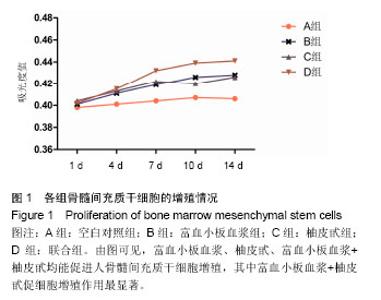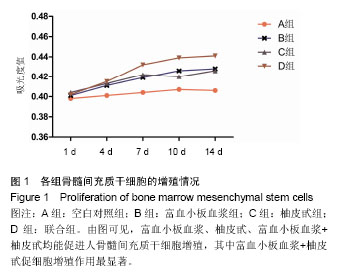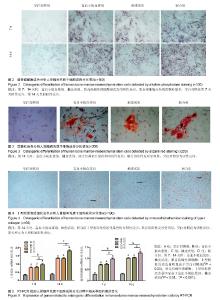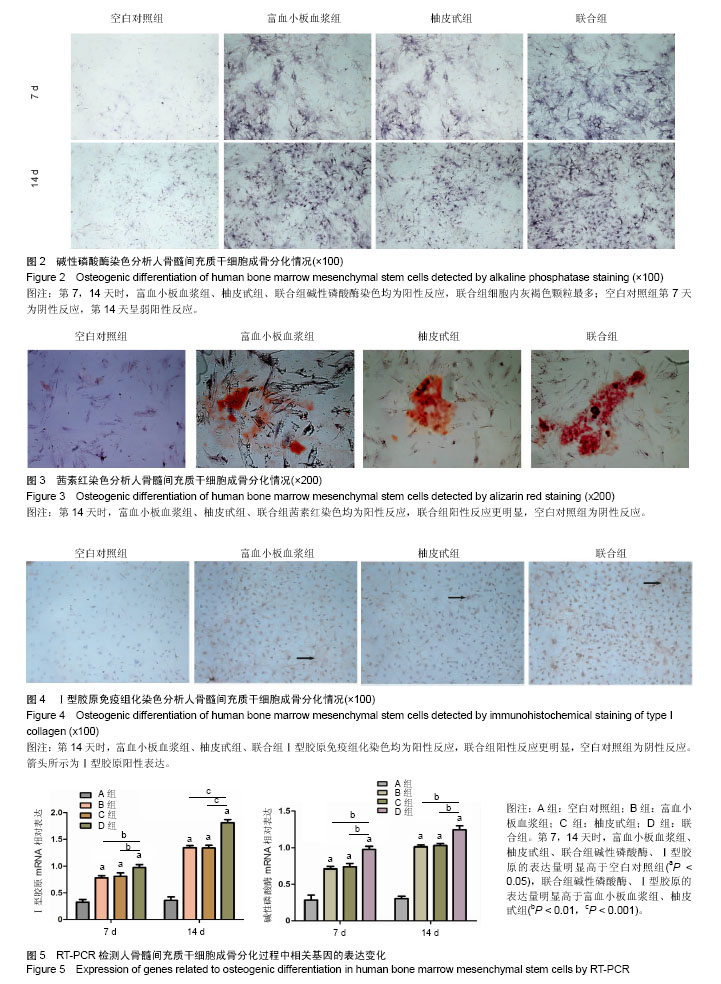| [1] 李斯翰,段建民,文军,等.富血小板血浆对骨髓间充质干细胞成骨向分化的作用[J].口腔医学研究,2015,31(7):735-738.[2] Gersch RP, Glahn J, Tecce MG, et al. Platelet Rich Plasma Augments Adipose-Derived Stem Cell Growth and Differentiation. Aesthet Surg J. 2017;37(6):723-729.[3] Yu GY, Zheng GZ, Chang B, et al. Naringin Stimulates Osteogenic Differentiation of Rat Bone Marrow Stromal Cells via Activation of the Notch Signaling Pathway. Stem Cells Int. 2016;2016:7130653.[4] Boesen AP, Hansen R, Boesen MI, et al. Effect of High-Volume Injection, Platelet-Rich Plasma, and Sham Treatment in Chronic Midportion Achilles Tendinopathy: A Randomized Double-Blinded Prospective Study. Am J Sports Med. 2017;45(9):2034-2043.[5] Parsons P, Butcher A, Hesselden K, et al. Platelet-rich concentrate supports human mesenchymal stem cell proliferation, bone morphogenetic protein-2 messenger RNA expression, alkaline phosphatase activity, and bone formation in vitro: a mode of action to enhance bone repair. J Orthop Trauma. 2008;22(9):595-604.[6] Park EJ, Kim ES, Weber HP,et al. Improved bone healing by angiogenic factor-enriched platelet-rich plasma and its synergistic enhancement by bone morphogenetic protein-2. Int J Oral Maxillofac Implants. 2008;23(5):818-826.[7] Gersch RP, Glahn J, Tecce MG, et al. Platelet Rich Plasma Augments Adipose-Derived Stem Cell Growth and Differentiation. Aesthet Surg J. 2017;37(6):723-729.[8] 杨渊,李小峰,罗道明,等.柚皮甙诱导兔骨髓间充质干细胞的成骨特征[J].中国组织工程研究,2013,17(14):2603-2608.[9] 单连成,王刚,张长青,等.富血小板血浆对体外培养骨骼肌干细胞增殖及成骨活性的作用[J].中国组织工程研究与临床康复, 2009,13(20):3833-3834.[10] 王淼,王南,权正学,等.Hey1表达对9 BMP-9诱导下2 C3H10T1/2细胞的成骨分化及增殖影响[J].中国修复重建外科杂志,2016,30(3):279-285.[11] 杨志烈,王成龙,赵东峰,等. 淫羊藿苷对环磷酰胺化疗导致小鼠骨髓间充质干细胞成骨分化障碍的保护作用[J]. 中国组织工程研究,2016,20(6):777-784.[12] 农梦妮,曾高峰,宗少晖,等.黄精多糖调控骨髓间充质干细胞向成骨细胞分化[J].中国组织工程研究,2016,20(15): 2133-2139.[13] Li Y, Jiang T, Zheng L, et al. Osteogenic differentiation of mesenchymal stem cells (MSCs) induced by three calcium phosphate ceramic (CaP) powders: A comparative study. Mater Sci Eng C Mater Biol Appl.2017;80:296-300.[14] Fernandes G, Yang S. Application of platelet-rich plasma with stem cells in bone and periodontal tissue engineering. Bone Res. 2016;4:16036.[15] Thirunavukkarasu K, Miles RR, Halladay DL, et al. Stimulation of osteoprotegerin (OPG) gene expression by transforming growth factor-beta (TGF-beta). Mapping of the OPG promoter region that mediates TGF-beta effects. J Biol Chem. 2001;276(39):36241-36250.[16] Parizi AM, Oryan A, Shafiei-Sarvestani Z, et al. Human platelet rich plasma plus Persian Gulf coral effects on experimental bone healing in rabbit model: radiological, histological, macroscopical and biomechanical evaluation. J Mater Sci Mater Med. 2012;23(2):473-483.[17] Spencer EM, Liu CC, Si EC, et al. In vivo actions of insulin-like growth factor-I (IGF-I) on bone formation and resorption in rats. Bone. 1991;12(1):21-26.[18] Street J, Bao M, deGuzman L, et al. Vascular endothelial growth factor stimulates bone repair by promoting angiogenesis and bone turnover. Proc Natl Acad Sci U S A. 2002;99(15):9656-9661.[19] Jaiswal RK, Jaiswal N, Bruder SP, et al. Adult human mesenchymal stem cell differentiation to the osteogenic or adipogenic lineage is regulated by mitogen-activated protein kinase. J Biol Chem. 2000;275(13):9645-9652.[20] Fan J, Im CS, Cui ZK, et al. Delivery of Phenamil Enhances BMP-2-Induced Osteogenic Differentiation of Adipose-Derived Stem Cells and Bone Formation in Calvarial Defects. Tissue Eng Part A. 2015;21(13-14): 2053-2065.[21] Liu M, Li Y, Yang ST. Effects of naringin on the proliferation and osteogenic differentiation of human amniotic fluid-derived stem cells. J Tissue Eng Regen Med. 2017; 11(1):276-284.[22] Wang L, Zhang YG, Wang XM, et al. Naringin protects human adipose-derived mesenchymal stem cells against hydrogen peroxide-induced inhibition of osteogenic differentiation. Chem Biol Interact. 2015;242:255-261.[23] Nair MB, Varma HK, John A. Platelet-rich plasma and fibrin glue-coated bioactive ceramics enhance growth and differentiation of goat bone marrow-derived stem cells. Tissue Eng Part A. 2009;15(7):1619-1631.[24] 吴丹,李苏伶,王璐,等. 骨髓间充质干细胞诱导成骨细胞模型中活化转录因子4基因的表达[J].中国组织工程研究,2014, 18(1):21-26.[25] Wong RW, Rabie B, Bendeus M, et al. The effects of Rhizoma Curculiginis and Rhizoma Drynariae extracts on bones. Chin Med. 2007;2:13.[26] Lee JY, Nam H, Park YJ, et al. The effects of platelet-rich plasma derived from human umbilical cord blood on the osteogenic differentiation of human dental stem cells. In Vitro Cell Dev Biol Anim. 2011;47(2):157-164. |



